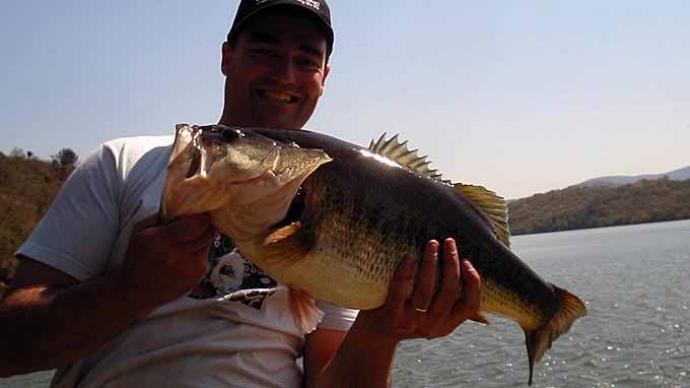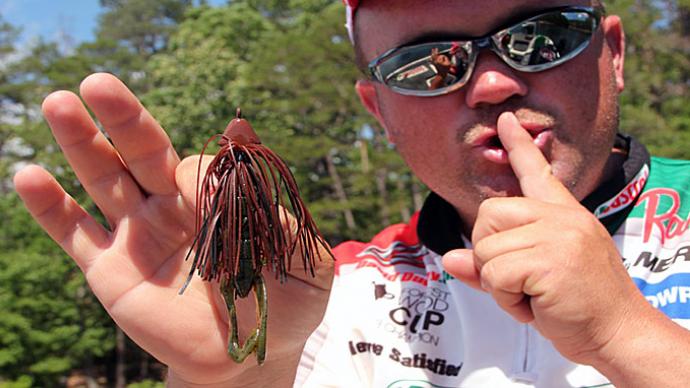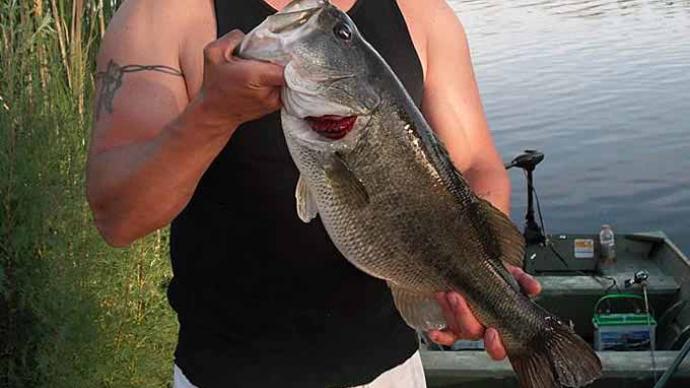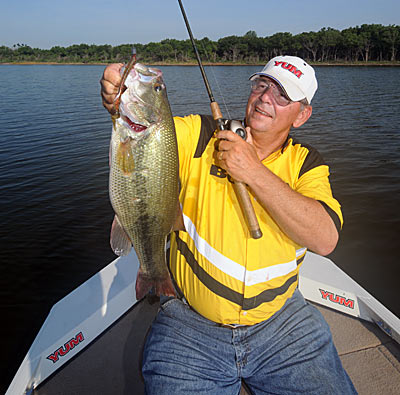
When the heat is on during the summertime, various tactics will catch bass shallow or deep, depending on the body of water you prefer fishing.
Power tactics with action lures and jigs on heavy tackle catch bass in murky waters full of thick cover, while finesse tactics with scaled-down lures on light tackle trick finicky bass in clear water lacking cover. Matching the right rod, reel, and line with the following summertime tactics will guarantee you will hook and land more bass.
Shallow Tricks
Mats of aquatic vegetation such as hydrilla, coontail moss, and milfoil provide plenty of shade and oxygen for shallow bass during hot weather. Penetrating the matted weeds with heavy, slow-moving lures such as 1/2- to 3/4-ounce jigs or Texas-rigged plastic worms pegged to 3/4- or 1-ounce bullet weights requires a 7 1/2-foot flipping stick and a medium-speed (6.2:1 gear ratio) baitcast reel filled with 65- to 80-pound braided line.
Flipping and pitching to wood works best when a lake is high and murky, and bass seek shelter in flooded bushes, laydowns, and drift piles. Try flipping or pitching jigs and Texas-rigged soft plastics on a 7- or 7 1/2-foot heavy action rod and medium-speed baitcast reel spooled with 25-pound test fluorocarbon line.
Retrieving a 1/2-ounce Rat-L-Trap at a fast clip produces along main lake points adjacent to channel swings early and late in the day or during power generation periods when bass move up shallow to feed. This tactic requires a 7-foot medium-heavy action rod, high speed (7.1:1 gear ratio or higher) baitcast reel, and 25-pound fluorocarbon.
Root systems of stumps are perfect hiding places for bass in the shallows. Work topwater chuggers and Zara Spooks over this cover in the morning on a 7-foot medium action rod, high-speed baitcast reel, and 14-pound monofilament line. Later in the day, run medium-diving crankbaits into the trunks and roots of stumps with the same gear.
Deep Tactics
Bottom-hugging bass in deep water can be coaxed into biting by hopping a 1/2- to 3/4-ounce jigging spoon off the lake’s floor. Vertical jig the spoon over long points, submerged humps or ridges with a 7-foot medium-heavy rod, high-speed baitcast reel, and 17- or 20-pound fluorocarbon.
Man-made brush piles placed on deep-water structure are bass magnets in the summertime. Work a Texas-rigged plastic worm through the brush with a 7- or 7 1/2-foot medium-heavy rod and high-speed baitcast reel filled with 14- or 17-pound fluorocarbon line.
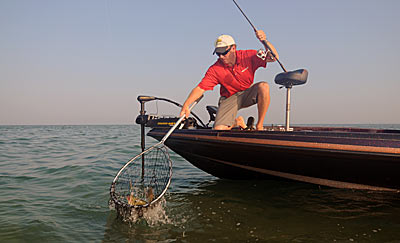
Slowly walking a Zara Spook or twitching a topwater chugger will draw bass suspended over deep water to the surface when you are fishing a deep, clear impoundment. Throw these topwater baits on a 7-foot medium action rod, high-speed baitcast reel, and 12- or 14-pound monofilament.
Hot-water bass on some lakes can be caught on a technique called “stroking,” a jig. Use a 7 1/2-foot heavy action rod and high-speed baitcast reel with 17- or 20-pound fluorocarbon to “stroke” a jig off the bottom by lifting your rod in a motion similar to a hook-set.
Banging a deep-diving crankbait into brush piles or bouncing it off the bottom along drop-offs of flats and channel swings trigger reaction strikes from bass. Using lighter line (10- to 12-pound fluorocarbon) allows these lures to reach their optimum depths when cranked on a 7 1/2- or 8-foot medium action rod and 5.2:1 gear ratio baitcast reel.
Drag a Carolina-rigged soft plastic along the bottom with a 7 1/2- or 8-foot medium-heavy rod and high-speed baitcast reel to catch bass along underwater humps, flats, and long gravel points. Spool your reel with either 30-pound braid or 20-pound fluorocarbon and tie on a leader line of 12-or 14-pound fluorocarbon.
Slow-rolling a 3/4- to 1-ounce spinnerbait through a brush pile or over rock ledges entices big bass on summer nights. The best gear matchup for fishing the heavy blade bait at night is a 7-foot medium-heavy rod and 6.1:1 baitcast reel filled with 17- or 20-pound fluorocarbon.
Finesse Fishing
Vertical jigging a plastic grub or finesse worm catches plenty of summertime spotted bass on deep clear reservoirs. Present these lures on a medium action 6 1/2-foot spinning rod and opt for a size 20 spinning reel, which permits you to use lighter line such as 6- or 8-pound test monofilament.
A vertical presentation with a drop shot rig allows you to keep a soft-plastic bait in a summertime bass’ strike zone longer. A 7-foot medium-action spinning rod is ideal for this presentation. Match the rod with a size 20 spinning reel filled with 6- or 8-pound fluorocarbon line.
Dragging a tube bait along the bottom is a popular tactic for catching summertime smallmouth bass on Northern natural lakes. The best tackle for tube dragging includes a 7-foot medium action spinning rod, size 20 or 30 spinning reel, and 8-pound test monofilament or fluorocarbon line.


